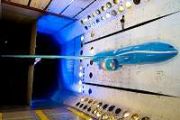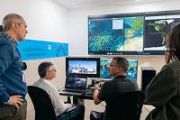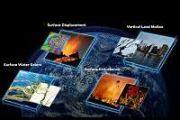
Copernical Team
NASA uncovers complex teamwork in magnetic bacteria
 In a breakthrough study, researchers backed by NASA have explored the remarkable cooperative behavior of a rare form of bacteria that function as if they were a unified multicellular entity. These organisms, known as multicellular magnetotactic bacteria (MMB), are the only bacteria currently known to display this specific type of obligate multicellularity, offering a compelling model for how com
In a breakthrough study, researchers backed by NASA have explored the remarkable cooperative behavior of a rare form of bacteria that function as if they were a unified multicellular entity. These organisms, known as multicellular magnetotactic bacteria (MMB), are the only bacteria currently known to display this specific type of obligate multicellularity, offering a compelling model for how com Mammals were shifting to ground life long before dinosaur extinction
 New findings from the University of Bristol suggest that mammals had begun transitioning from arboreal habitats to terrestrial ones several million years prior to the asteroid strike that caused the extinction of the dinosaurs.
Published in the journal Palaeontology, the research highlights that numerous mammalian species were already adapting to life on the ground before the catastrophic
New findings from the University of Bristol suggest that mammals had begun transitioning from arboreal habitats to terrestrial ones several million years prior to the asteroid strike that caused the extinction of the dinosaurs.
Published in the journal Palaeontology, the research highlights that numerous mammalian species were already adapting to life on the ground before the catastrophic A new path for quantum connections
 Applied physicists at the Harvard John A. Paulson School of Engineering and Applied Sciences (SEAS) have developed a photon-routing device that could significantly enhance the interface between optical and microwave quantum systems, potentially enabling large-scale, modular quantum computing over existing telecom networks.
This innovation could pave the way for quantum computers that are n
Applied physicists at the Harvard John A. Paulson School of Engineering and Applied Sciences (SEAS) have developed a photon-routing device that could significantly enhance the interface between optical and microwave quantum systems, potentially enabling large-scale, modular quantum computing over existing telecom networks.
This innovation could pave the way for quantum computers that are n Carbon Robotics debuts autonomous tractor system with live remote control capability
 Carbon Robotics has unveiled Carbon AutoTractor, a new autonomy system that transforms conventional tractors into driverless machines, monitored and managed in real time by trained human operators. Built around the Carbon AI platform, the solution is designed to deliver continuous, dependable autonomous operations for farms seeking to scale up productivity and address labor shortages.
This
Carbon Robotics has unveiled Carbon AutoTractor, a new autonomy system that transforms conventional tractors into driverless machines, monitored and managed in real time by trained human operators. Built around the Carbon AI platform, the solution is designed to deliver continuous, dependable autonomous operations for farms seeking to scale up productivity and address labor shortages.
This Karman expands spacecraft production with advanced clean room facility
 Karman Space and Defense (NYSE: KRMN), a prominent provider of precision-engineered systems for missiles, uncrewed aerial vehicles, and spacecraft, has unveiled a new ISO 8 clean room facility at its Washington site. This state-of-the-art space is purpose-built to handle the assembly and integration of next-generation space hardware, including lunar landers, satellite platforms, and habitat modu
Karman Space and Defense (NYSE: KRMN), a prominent provider of precision-engineered systems for missiles, uncrewed aerial vehicles, and spacecraft, has unveiled a new ISO 8 clean room facility at its Washington site. This state-of-the-art space is purpose-built to handle the assembly and integration of next-generation space hardware, including lunar landers, satellite platforms, and habitat modu Honda to test renewable tech in space soon
 Honda will partner with US companies to test in orbit a renewable energy technology it hopes to one day deploy on the Moon's surface, the Japanese carmaker announced Friday.
The auto giant is developing a mechanism capable of generating electricity and oxygen continuously - enabling astronauts to breathe - thanks to solar energy and water known to be present in some lunar soils.
Now i
Honda will partner with US companies to test in orbit a renewable energy technology it hopes to one day deploy on the Moon's surface, the Japanese carmaker announced Friday.
The auto giant is developing a mechanism capable of generating electricity and oxygen continuously - enabling astronauts to breathe - thanks to solar energy and water known to be present in some lunar soils.
Now i New geointelligence tool streamlines land mapping and resource planning
 Researchers at the Tupa campus of Sao Paulo State University (UNESP) have introduced a new geospatial intelligence method designed to improve the speed and precision of land use monitoring and territorial planning. The approach successfully delineates key landscape features, such as Amazon rainforest, Cerrado vegetation, pastures, and areas of intensive agriculture with double-cropping systems.
Researchers at the Tupa campus of Sao Paulo State University (UNESP) have introduced a new geospatial intelligence method designed to improve the speed and precision of land use monitoring and territorial planning. The approach successfully delineates key landscape features, such as Amazon rainforest, Cerrado vegetation, pastures, and areas of intensive agriculture with double-cropping systems. NASA Makes Progress on Advanced Drone Safety Management System
 From agriculture and law enforcement to entertainment and disaster response, industries are increasingly turning to drones for help, but the growing volume of these aircraft will require trusted safety management systems to maintain safe operations.
NASA is testing a new software system to create an improved warning system - one that can predict hazards to drones before they occur. The In-
From agriculture and law enforcement to entertainment and disaster response, industries are increasingly turning to drones for help, but the growing volume of these aircraft will require trusted safety management systems to maintain safe operations.
NASA is testing a new software system to create an improved warning system - one that can predict hazards to drones before they occur. The In- AFWERX backs Slingshot AI tech to monitor suspicious satellite activity
 Slingshot Aerospace has been selected by AFWERX to support the U.S. Department of Defense with advanced machine learning tools under its Rapid Analysis of Photometric Tracks for space Object identification and behavior Recognition (RAPTOR) initiative. This program aims to enhance situational awareness in low Earth orbit by analyzing the behavior of satellites and other spaceborne objects.
Slingshot Aerospace has been selected by AFWERX to support the U.S. Department of Defense with advanced machine learning tools under its Rapid Analysis of Photometric Tracks for space Object identification and behavior Recognition (RAPTOR) initiative. This program aims to enhance situational awareness in low Earth orbit by analyzing the behavior of satellites and other spaceborne objects. Existing laws offer pathway to prevent warfare in space
 World governments should look to current international legal frameworks to curb the growing militarization of space, according to a new study that emphasizes the urgent need to prevent conflict in orbit.
Outer space is increasingly viewed as a potential battlefield, prompting concerns over the absence of enforceable limitations on military activity beyond Ear
World governments should look to current international legal frameworks to curb the growing militarization of space, according to a new study that emphasizes the urgent need to prevent conflict in orbit.
Outer space is increasingly viewed as a potential battlefield, prompting concerns over the absence of enforceable limitations on military activity beyond Ear 



































